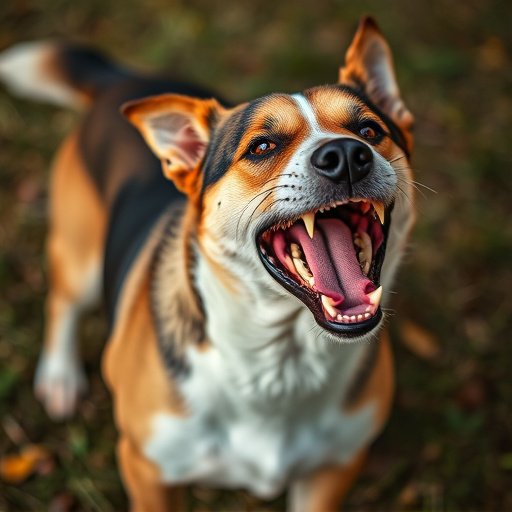Dog aggression arises from triggers like fear and territoriality. Neutralizing mace spray for pets is a safer alternative to traditional pepper spray for deterring attacks. Effective deployment requires understanding application techniques. Training and behavior modification are key to addressing aggression before considering pepper spray, with desensitization and counter-conditioning techniques. Laws govern the possession and use of dog attack neutralizer sprays, emphasizing responsible use.
Dog attacks can be a frightening experience, but taking preventive measures is crucial. This article explores an innovative solution: stop dog attack pepper spray. We delve into understanding the triggers of dog aggression and provide insights into safer alternatives to traditional mace sprays. Learn effective application techniques for neutralizing pet skin while ensuring legal compliance. Discover training strategies that modify behavior, making your canine companion more manageable in various situations.
- Understanding Dog Aggression Triggers
- Exploring Pepper Spray Alternatives for Dogs
- Application Techniques for Safe Use on Pets
- Legal Considerations: Pet Pepper Spray Ownership
- Training and Behavior Modification Strategies
Understanding Dog Aggression Triggers
Dog aggression can be a complex behavior, often stemming from various triggers and past experiences. Understanding these triggers is crucial for effectively managing and preventing potential attacks. Common agitating factors include fear, territorial behavior, or even a history of abuse or neglect. For instance, a dog may become aggressive when it perceives a threat to its territory, such as an intruder in its home or a new pet in the neighborhood. Additionally, dogs with anxiety or phobias might react violently when faced with specific triggers like loud noises, unfamiliar people, or certain types of movement.
Identifying these triggers is essential before considering any form of intervention, including the use of neutralizing mace spray on pet skin. Knowing what sets off a dog’s aggressive behavior allows owners and handlers to take preventive measures. This may involve desensitization training, creating a safe and secure environment, or learning to interpret a dog’s body language to avoid escalating situations.
Exploring Pepper Spray Alternatives for Dogs
When considering alternatives to traditional pepper spray for dog attacks, it’s crucial to explore safer and more humane options that can effectively neutralize potential threats without causing harm to your pet or others. One promising alternative is neutralizing mace spray designed specifically for pets, which offers a targeted approach to deterring aggressive behavior. These specialized sprays are formulated to be less irritating than standard human pepper spray, making them a safer choice for dogs while still providing a powerful deterrent.
Unlike conventional pepper spray, pet-specific neutralizers often contain natural ingredients and mild active agents that can disrupt an animal’s sense of smell or cause temporary disorientation without leading to long-lasting health issues. This ensures the safety and well-being of your dog while allowing you to navigate potentially dangerous situations more effectively.
Application Techniques for Safe Use on Pets
When using stop dog attack pepper spray, understanding application techniques is crucial for safe and effective deployment. The first step involves assessing the situation to determine the appropriate spray type and amount needed. Hold the can upright and at arm’s length, aiming towards the animal’s face and eyes. This ensures a direct hit, neutralizing the threat quickly.
For pets, a light misting is often sufficient to deter an attack without causing excessive discomfort or harm. It’s essential not to over-spray, as this could lead to skin irritation or inhalation issues. After application, ensure you stay back and observe your pet for any signs of distress, such as coughing or difficulty breathing. If needed, seek immediate veterinary care. Remember, the goal is to stop the aggression without causing lasting harm.
Legal Considerations: Pet Pepper Spray Ownership
In many regions, owning pepper spray for self-defense, including specialized dog attack neutralizer sprays, is legal as long as it’s used responsibly and in accordance with local regulations. However, there are strict rules governing who can possess and carry such items. Typically, these laws categorize individuals into specific groups: law enforcement officers, military personnel, and civilians. For the latter group, obtaining a pepper spray designed for dog attacks may require a valid reason, such as living in an area with a high risk of encounters with aggressive dogs or having a history of such incidents.
The legal implications extend beyond ownership. Using neutralizing mace spray on pet skin also falls under these regulations. While it’s intended to protect both pets and their owners during intense dog attacks, users must ensure they comply with local laws regarding the use of force and self-defense tools. This includes understanding safe application methods and distance restrictions to avoid unnecessary harm or legal repercussions.
Training and Behavior Modification Strategies
Training and behavior modification strategies are essential in addressing dog aggression issues before considering pepper spray as a last resort. Positive reinforcement training, led by professional dog trainers, can teach dogs alternative responses to triggers that might incite an attack. This involves rewarding calm behaviors with treats or praise, helping the dog associate certain situations with positive outcomes.
Behavioral modification techniques, such as desensitization and counter-conditioning, aim to change a dog’s emotional response to stimuli. Gradual exposure to potential threats, like neutralizing mace spray on pet skin during controlled training sessions, can help dogs become less reactive over time. These methods require patience, consistency, and the guidance of experts to ensure safety and effectiveness.
In conclusion, while pepper spray can be a tool to safely neutralize dog attacks, it’s crucial to understand its application techniques, legal considerations, and explore alternative strategies like behavior modification. By addressing the root causes of aggression and employing various methods, pet owners can enhance their pets’ safety and well-being, ensuring a peaceful coexistence with their four-legged companions. Remember, proper training and a deep understanding of your dog’s triggers are key to navigating this approach effectively.
